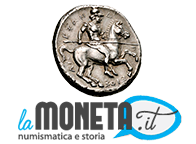Cerca nel Forum
Risultati per Tag '1926 Sesquicentennial half'.
Trovato 1 risultato
-
Gli Stati Uniti stava ancora lavorando fuori un surplus di mezzo-dollari durante gli anni venti, così c'erano nessun half-dollars di emissione regolare ha colpito nel 1924, 25 e 26. Un numero limitato di nuovi half-dollars commemorativa ha fatto apparire, tuttavia. Ecco il mezzo-dollaro 1926, per commemorare il Sesquicentennial (150° anniversario) dell'indipendenza dei Stati Uniti d'America. Colpito—molto opportunamente—in Philadelphia (dove fu firmata la dichiarazione d'indipendenza), di .900 d'argento fine, per le stesse specifiche come il regolare numero circolanti poi mezzo-dollari. Degli 1.000.000 esempi coniati, alcuni 859.408 sono stati fusi. Uno dei 140.592 sopravvissuti: Il bassorilievo di questo mezzo-dollaro del Sesquicentennial 1926 ruba e di gran parte del suo fascino commemorativa, penso. Ma la Liberty Bell è completamente realizzato e arrotondati sul ‘26 mezzo-dollaro in un modo che non è su Franklin metà di ‘48, tuttavia, così questo commemorative sono suoi punti di forza. Credito di progettazione sia per la commem ‘26 e la ‘48 Franklin va a John R. Sinnock, ma è spesso notato che John Frederick Lewis dovrebbe ottenere almeno alcuni del credito per il design della campana della libertà inversa. Per confronto, il Franklin inverso: Un cento e cinquanta anni di indipendenza americana meritava una celebrazione corposi, penso, e il 1926 troppo-delicato mezzo-dollaro commemorativo era non appena esso. Si noti che "Silent Cal" (presidente Calvin Coolidge, che era famoso per non parlare molto), fa la sua apparizione su questa moneta—il primo di un presidente americano durante la sua vita. Queste monete erano destinate a raccogliere fondi per il 1926 Sesquicentennial Exposition di Filadelfia e sono stati raggiunti nella celebrazione dell'America dell'evento da un (molto più muscoloso) francobollo 2-centesimi con la Liberty Bell in carminio e bianco. Un ultima nota, circa i molti half-dollars Sesquicentennial 1926 che si trovano leggermente usurati: come è il caso con molti americani mezza-dollari commemorative coniate prima della grande depressione, alcune di queste monete sono stati spesi in circolazione durante i tempi duri degli anni trenta. E scommetto—dato loro soggetto e soprattutto nei vecchi giorni quando foto immagini erano più duri da trovare quello che sono ora—che almeno alcune di queste monete sono stati al centro di una lezione tavolo da pranzo sulla storia americana, ha detto il padre e madre al bambino, con abbondanza di gestione della moneta, e girandolo più e più volte come la narrazione necessaria. :) v. ------------------------------------------------------ The U.S. was still workin-g off a half-dollar surplus during the 1920s, so there were no regular issue half-dollars struck in 1924, ‘25, and ‘26. Limited numbers of new commemorative half-dollars did appear, however. Here’s the 1926 half-dollar commemorating the Sesquicentennial (150th anniversary) of the independence of the United States of America. Struck—very appropriately—in Philadelphia (where the Declaration of Independence was signed), of .900 fine silver, to the same specifications as the regular issue half-dollars then circulating. Of the 1,000,000 examples coined, some 859,408 were melted. One of the 140,592 survivors: The low relief of this 1926 Sesquicentennial half dollar robs it of much of its commemorative appeal, I think. But the Liberty Bell is fully-realized and rounded on the ’26 half dollar in a way that it isn’t on the Franklin half of ’48, however, so this commemorative does have its strengths. Design credi-t for both the ’26 commem and the ’48 Franklin goes to John R. Sinnock, but it is often noted that John Frederick Lewis should get at least some of the credi-t for the design of the reverse Liberty Bell. For comparison, the Franklin reverse: A hundred and fifty years of American independence deserved a full-throated celebration, I think, and the too-delicate 1926 commemorative half dollar just wasn’t it. Note that “Silent Cal” (President Calvin Coolidge, who was famous for not talking much.) makes an appearance on this coin—the first by an American president during his lifetime. These coins were intended to raise mone-y for the 1926 Sesquicentennial Exposition in Philadelphia, and were joined in America’s celebration of the event by a (much more muscular) 2-cent postage stamp featuring the Liberty Bell in carmine and white. One last note, about the many 1926 Sesquicentennial half-dollars that are found slightly worn: as is the case with many American commemorative half dollars coined before the Great Depression, some of these coins were spent into circulation during the hard times of the 1930s. And I’ll bet—given their subject, and especially in the old days when picture images were harder to come by than they are now—that at least a few of these coins have been the focus of a dinner-table lesson about American history, told parent to child, with plenty of handling of the coin, and turning it over and over as the narrative required. :) v.
Lamoneta.it
La più grande comunità online di numismatica e monete. Studiosi, collezionisti e semplici appassionati si scambiano informazioni e consigli sul fantastico mondo della numismatica.
Il network
Hai bisogno di aiuto?




